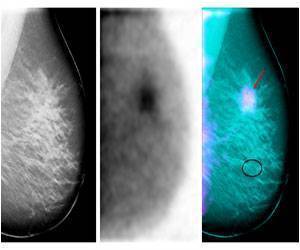The stiffening of breast tissue in breast-cancer development points to a new way to distinguish a type of breast cancer with a poor prognosis from a related, but often less deadly type.

In a mouse model of breast cancer, scientists led by Valerie Weaver, PhD, professor of surgery and anatomy and director of the Center for Bioengineering and Tissue Regeneration at UCSF, identified a biochemical chain of events leading to tumor progression. Significantly, this chain of events was triggered by stiffening of scaffolding tissue in the microscopic environment surrounding pre-cancerous cells. The stiffening led to the production of a molecule that can be measured in human breast cancer tissue, and which the researchers found was associated with worse clinical outcomes.
"This discovery of the molecular chain of events between tissue stiffening and spreading cancer may lead to new and more effective treatment strategies that target structural changes in breast cancers and other tumors," Weaver said.
In the mouse experiments, Janna Mouw, PhD, a UCSF associate specialist who works in Weaver's lab, found that tissue stiffening in microscopic scaffolding known as the extracellular matrix, or ECM, increases signaling by ECM-associated molecules, called integrins. The integrins in turn trigger a signaling cascade within cells that leads to the production of a tumor-promoting molecule called miR-18a.
Unlike most cellular signaling molecules thus far studied by scientists, miR-18a is not a protein or a hormone, but rather a microRNA, another type of molecule recognized in recent years to play an important role in the lives of cells. The miR-18a dials down the levels of a protective, tumor-suppressing protein called PTEN, which often is disabled in cancerous cells, leading to abnormal biochemical signaling that can promote cancer growth.
Stiffening of the tissue microenvironment in tumors
Advertisement
Armed with modern lab techniques, Weaver has made many discoveries about the mechanical and structural properties of tumor tissue and the stiffening that can occur. For example, she was the first to identify the cross-linking of structural elements within the ECM as a precursor to cancer progression.
Advertisement
Luminal A breast cancer accounts for about 40 percent of all breast cancers, while luminal B breast cancer comprises about 20 percent. On average, women with luminal B breast cancer do not survive as long after treatment without breast cancer recurring, and they are less likely to respond to hormone therapies such as tamoxifen. Lack of a good diagnostic tool results in overtreatment of many luminal A breast cancers, Weaver said.
According to Shelley Hwang, MD, PhD, chief of breast surgery at Duke University Hospital, former UCSF faculty member and a clinical collaborator for the Nature Medicine study, "Current methods for distinguishing luminal A breast cancer from luminal B breast cancer are expensive and time consuming, and are rarely used in medical practice." If a link between miR18a and luminal B breast cancer can be definitively confirmed, and if a reliable clinical laboratory test can be developed to measure miR18a in the tumor tissue, it would provide a practical way to distinguish the two tumor subtypes, Hwang said.
Laura Van't Veer, head of the breast oncology program at the Helen Diller Family Comprehensive Cancer Center at UCSF, and the developer of MammaPrint, a 70-gene test used to predict breast cancer spread, said the Nature Medicine study represents a major finding.
"The work provides early evidence that miR18a is a strong predictor of metastasis and poor survival in women with luminal breast tumors, and that it may be used to distinguish luminal A breast tumors from luminal B breast tumors," Van't Veer said.
Source-Eurekalert















